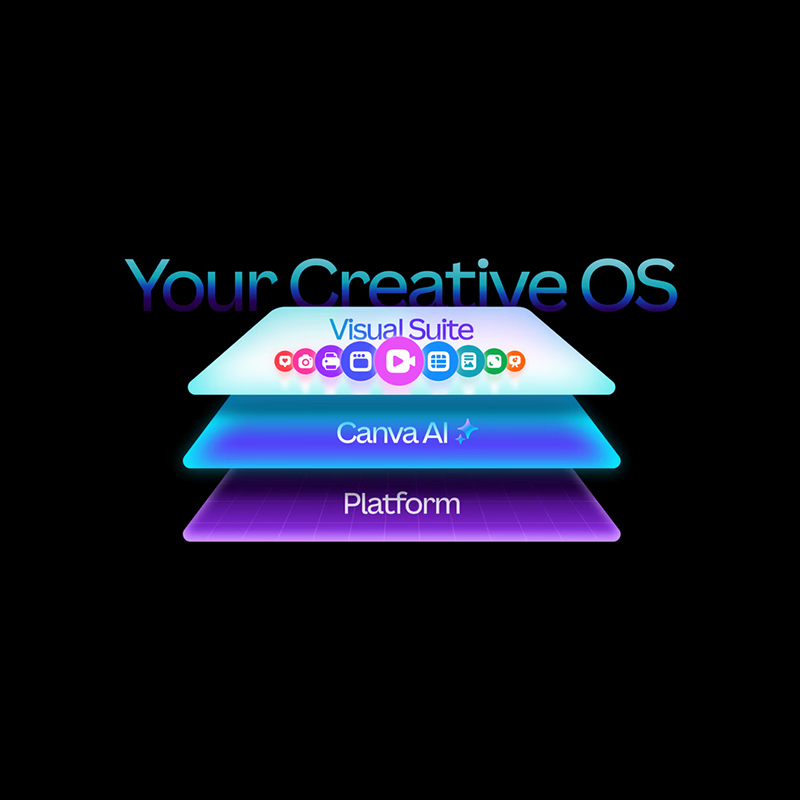
Canva has come a long way from its early days as a simple online design tool.
What began as a platform to make graphic design accessible to everyone has evolved into something far more ambitious. This is because now, Canva has become a full-fledged creative ecosystem. And with 'Creative Operating System,' the company is going boldly forward, in an attempt to rival Adobe's best products.
At the heart of this transformation lies a new generation of AI, a reimagined suite of design tools, and a bold vision for the future of creativity in what Canva calls the “Imagination Era.”
At its core, Canva’s new foundation is a design model built to understand the true complexity of creative work.
Unlike standard diffusion models that produce flat images, Canva’s model generates editable designs with layered elements and dynamic composition.
It comprehends how hierarchy, branding, and visual logic work together to produce content that’s not just beautiful, but editable, adaptable, and instantly usable across formats, from social media posts and presentations to websites and videos.
Our biggest product drop has landed. Introducing Canva’s Creative OS: new AI tools, Video 3.0, Email Design, Forms, and more, all built for the Imagination Era.
Read more: https://t.co/5E63daUlev— Canva (@canva) October 30, 2025
In the announcement, Canva said that:
The company’s new tools within this Creative OS expand far beyond design.
Its Visual Suite, for example, has been rebuilt to integrate every creative process into one seamless flow.
The upgraded Video 2.0 editor combines professional-grade features with Canva’s hallmark simplicity, allowing creators to sync, trim, and layer clips without friction. A new Magic Video tool can automatically assemble and polish footage based on a user’s description, while a growing library of templates inspired by popular TikTok and Reels styles ensures creators never start from scratch.
Yep, you heard it right. No watermarks, no paywalls, no awkward exports. Canva Video 2.0 is pure intuitive creative power at your fingertips. pic.twitter.com/IWWXs5POhB
— Canva (@canva) October 30, 2025
Canva’s Forms feature introduces a smarter way to gather input directly within a design, functioning as an alternative to tools like Google Forms.
Responses flow automatically into Canva Sheets, enabling users to visualize data or integrate it into interactive projects without switching platforms.
With the addition of Canva Code, users can even build custom widgets and data-powered experiences directly inside their projects, blending creativity with functionality in a way few tools can.
Create, customize, and export beautiful, on-brand emails all in one place with Canva’s new custom Email Design. pic.twitter.com/VqKLg36eMV
— Canva (@canva) October 30, 2025
The company has also introduced Canva Email Design, allowing users to create beautiful, brand-consistent email campaigns within the same ecosystem.
With drag-and-drop simplicity and AI-powered design suggestions, marketing teams can build polished templates and export clean HTML ready for any email platform. Meanwhile, a simple tag @Canva now turns the AI assistant into a collaborative partner.
Whether helping refine text, generate visuals, or offer layout advice, Canva’s assistant responds contextually to each project, staying aware of its tone, color palette, and style.
Introducing your newest creative partner, Ask @ Canva.
Designing in Canva is now as easy as having a conversation! pic.twitter.com/GerNBBRx4Y— Canva (@canva) October 30, 2025
Beyond individual design work, Canva is building a marketing engine.
Its new platform, Canva Grow, unites asset creation, publication, and performance tracking under one roof.
Marketers can design campaigns, publish directly to platforms like Meta, and analyze results, all guided by AI that learns from real performance data.
Well, now they are with...Canva Grow! Where every campaign learns from your last.
Because better ads = bigger results pic.twitter.com/OmAey36APi— Canva (@canva) October 30, 2025
The system can even scan a brand’s website to learn its voice and automatically generate ad variants that align with its identity. It’s a full-circle approach that promises to turn marketing workflows into continuous creative loops.
With the integration of the professional-grade Affinity suite, which is now offered completely free.
Introducing the new free Affinity: a fully reimagined professional design app combining photo, vector, and layout tools in one fast, responsive platform. It’s powerful. It’s pro. And it’s now completely free for everyone.
Read more: https://t.co/gVhCgK53KI— Canva (@canva) October 30, 2025
Canva most direct move towards Adobe's territory, should be the new 'Affinity by Canva' that merges vector, pixel, and layout design into a single powerful app available across Windows, macOS, and soon iPad.
The app connects seamlessly to Canva’s ecosystem, allowing users to start a design in Affinity and refine or scale it in Canva.
While the core tools remain free, AI-powered features such as generative fill and background removal are available through Canva’s premium plans. Affinity’s team, now under Canva’s leadership, emphasizes that these features are built with privacy in mind and that user data will not be used to train AI models.
Canva’s updates also highlight its larger philosophical shift, which shows how it wishes to move away from the Information Era to what it calls the Imagination Era.
The company believes technology should no longer just help people access information but should amplify creativity itself. In this new paradigm, imagination becomes the driving force of progress, with AI serving as a tool that bends to human vision rather than replacing it.
Time to meet Canva’s brand new Brand System. The most powerful way to manage your brand at scale. pic.twitter.com/ss8l8eBtge
— Canva (@canva) October 30, 2025
Every part of Canva’s massive release points toward this future.
From intelligent design assistance and automated video editing to brand systems that ensure global consistency, the platform aims to make creativity accessible at scale. It’s not just about making things easier to design because to Canva, at least, it’s about making imagination frictionless.
And with its expanding ecosystem, spanning design, marketing, data visualization, and professional creative tools, Canva is positioning itself not as a competitor to Adobe, Google, or Microsoft, but as something entirely new: a single, unified space where ideas move effortlessly from spark to reality.
In this Imagination Era, Canva wants to be the platform where the world’s creativity comes to life, one prompt, one pixel, one idea at a time.
